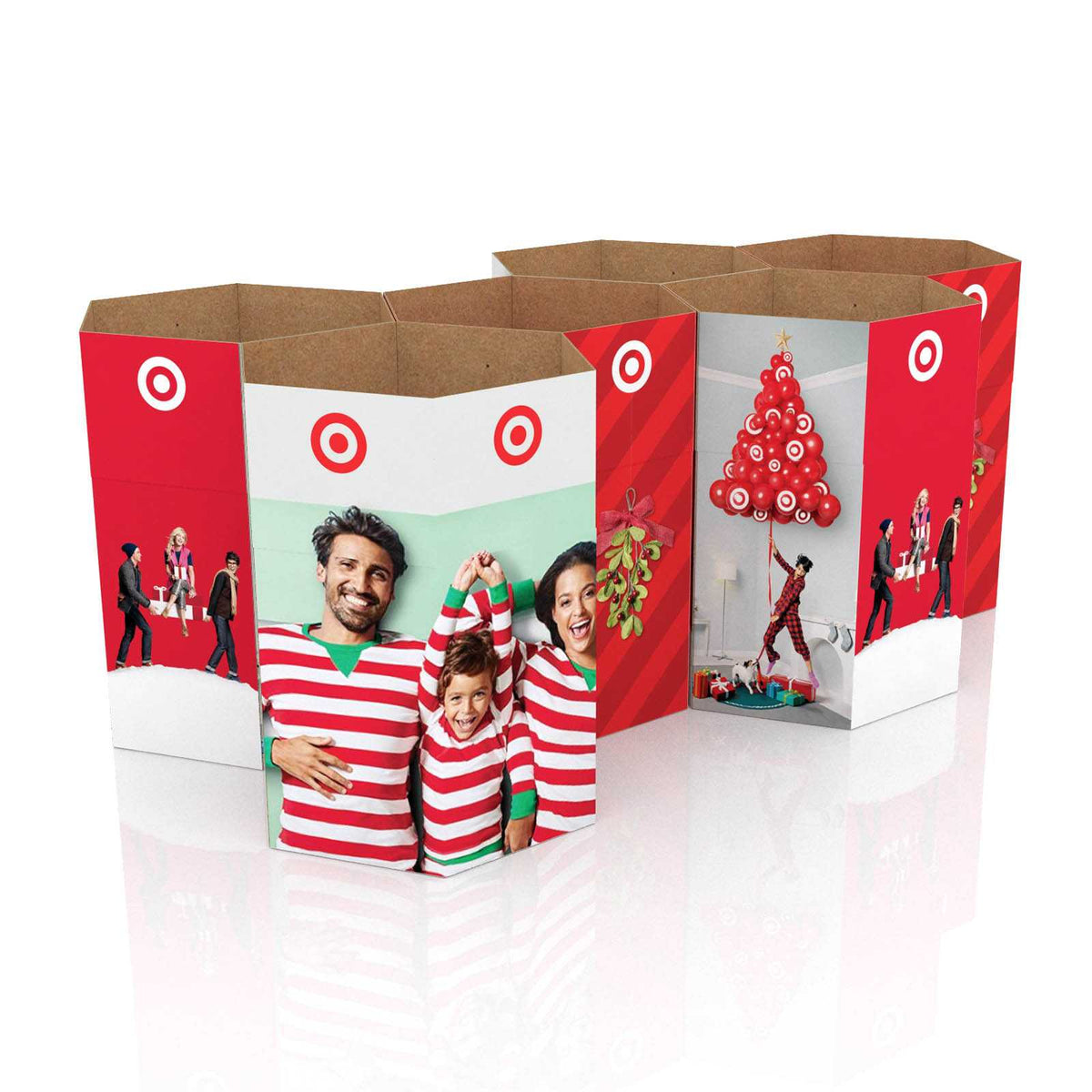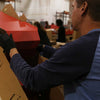

One-Piece Dump Bins
Are you looking to sell small or bulk merchandise at retail or rearrange your floor plan? Then a cardboard dump bin might be exactly what you need.
Custom dump bin displays are one of the simplest ways to organize products at retail that you don’t have the ability to stack or hang. They can take bulk merchandise and still present it to the customer in an attractive way. There are so many benefits to these displays!
Keep reading to learn about creating custom cardboard Dump bin displays.
Table Of Contents
Aspects of a Dump Bin
- Billboard style size allowing for brand awareness opportunities
- Vary in size and shape depending on products
- One-piece designs are in demand
- Great for bulk and sales merchandise in high-traffic areas
- Full print options to allow for bold, attention-grabbing aesthetics
- We are pre-approved with most retailer and club store requirements
Why One-Piece Dump Bins Matter
First, what’s a one-piece Dump Bin? Well, most manufacturers can’t create a dump bin out of one piece of corrugated material; instead, they create two printed pieces and then glue them together.
That means extra production time and money to assemble and glue them before shipping. Using a two-piece design also results in a less attractive display because the graphics can be disturbed at two points due to gluing.
Thanks to our Jumbo Die Cutter, we are one of the only manufacturers in North America that can create one-piece dump bins. Here are some benefits of one-piece designs:
- More attractive display
- Cheaper production
- Less production time
- Easier customization
6 Expert Tips: Designing Custom Dump Bins
Here are 6 expert tips for you and your design team when designing your next custom Dump Bin displays.
1. Define The Project
The first step in designing a retail display is to define your project. Carefully constructing an overall goal for your display is key to success.
Every design and logistic choice will revolve around this initial vision statement. Otherwise, you’ll get lost in a spiral of possibilities.
Are you introducing a new product to the marketplace, creating a new niche, or simply looking to move 10% more products?
Set that goal upfront and ensure you know where the ship is headed.
2. Choose Your Products
Next, consider which products are best served in a Dump Bin. These displays are extremely durable, perfect for heavier items or resisting a shop-worn look.
One great approach is a sampler or combination pack of items. These can include lotions, DVDs, cooking equipment, and more. They should be typically purchased together to increase the chances of a buy.
Another approach is a “grab and go” product selling choice. These can be essentials like school supplies or focus on health and beauty. They are focused around key categories and are irresistible packages.
3. Use A Divider
Next, think about separation. While many brands will simply toss their products inside a dump bin and hope for sales, consider using a divider.
A simple cardboard divider can separate different product types and encourage customers to purchase individual products instead of pre-packaging them.
One of the best design tips for dividers is using color coordination, whether it’s packaging colors or some type of additional corrugated header. The colors will draw them in and help them quickly see the different products.
4. Market With The Billboard
Now comes one of the most important aspects of a dump bin: the billboard. Thanks to the dump bins’ large panel size, you can include a lot of branding information.
You can advertise individual products, special sales events, or the brand as a whole. The choices you include that fit your overall brand are crucial to the customer experience.
If you choose a display that includes your brand's mission statement and key product benefits, your customers will purchase with confidence.
5. Enhance Your Brand
Now, most display designs have diminishing returns, which means less is more. Your color choice, graphics, and messaging must focus on the key stages of the buying consideration phase.
From a distance, next to your display, interacting with your product, and putting it in their basket.
Can you tell your brand story? Or how about key images of people using the product? How can you enhance your brand at retail and draw customers in?
Related: Increase Sales With Dump Bin Displays
6. Simplicity Is Key
Next, create something specific that grabs their attention. What about your offer can be unique? Is it a one-time-only item? Does it tie in with a sports event? Think about that unique offering.
You also need to keep your messaging concise. You can’t sell your customers a laundry list of information.
You must first give them bullet points of essential information to draw them in. Then, smaller fonts with additional product information should be included so that they can continue to read.
6 Benefits of Digital Printing
Creating a custom retail display and bringing it to market is now less expensive than ever. Digital Printing allows you to quickly prototype, adjust your messaging, and change with the marketplace.
Here are 6 benefits of Digital Printing that will take your brand from plain to premium.
1. Tooling Costs
When you want to create a retail display, other printing methods require several weeks of lead time and upfront costs to create printing plates. That means you need an upfront budget before you get your first display.
These are one-time costs that can discourage many brands from creating alternate designs. Imagine if you didn’t need to factor those into your budget. Where else could that money go?
2. Cost-Effective
Finally, Digital Printing gives you the best bang for your buck. There is no minimum for it thanks to the no-tooling costs.
Make a product and attack a new niche directly. Create prototypes while you figure out the marketplace.
No matter your reason for looking at Digital, there’s a great reason to try it.
3. Design Variations
First, let’s talk about designs. So many brands take a one-size-fits-all approach to their retail displays, and that’s because they’re using traditional methods.
Imagine creating a single dieline but multiple graphic options. More displays + more products = more sales.
Related: 5 Design Tips For Dump Bin Displays
4. “One Time Only”
Next, create a special sales event and print it directly on your display, maybe with an alternate header. If you put your packaging on a display and the packaging stands out with a fresh design, that will increase sales!
Or, if you are heading to a trade show, you can adjust your displays to match the event quickly and without additional costs or lead time. No other method allows you to do that.
5. Printing “On-The-Fly”
Next, consider the speed to market that Digital Printing offers. Deliver alternate artwork to Bennett, and it will be printed on your display by the end of the day.
What other printing method can give you that?
Related: 5 More Digital Printing Tips For Dump Bins
6. Branding Opportunities
Your display is the first interaction most customers will have with your product. That means you need to bring as much creativity to the display as you do your packaging and your product.
Adjusting your messaging with the marketplace can help you create a successful product launch with eye-catching designs.
Are you going through a brand refresh? Send the new art file.
Need more tips? Check out our complete guide to Dump Bin Displays!
Bennett Creates Cardboard Dump Bins
Bennett is a premier packaging and retail displays manufacturing company striving to protect and promote our clients' products with customized corrugated solutions. When you work with us, you’re part of the family. We will partner with you every step of the way.
With our fully integrated design-to-delivery process, we can be the single supplier source. We are an award-winning manufacturer of virtually anything corrugate. We offer everything from plain brown shipping boxes to sophisticated, high-graphic printed point-of-purchase displays and everything in between.




